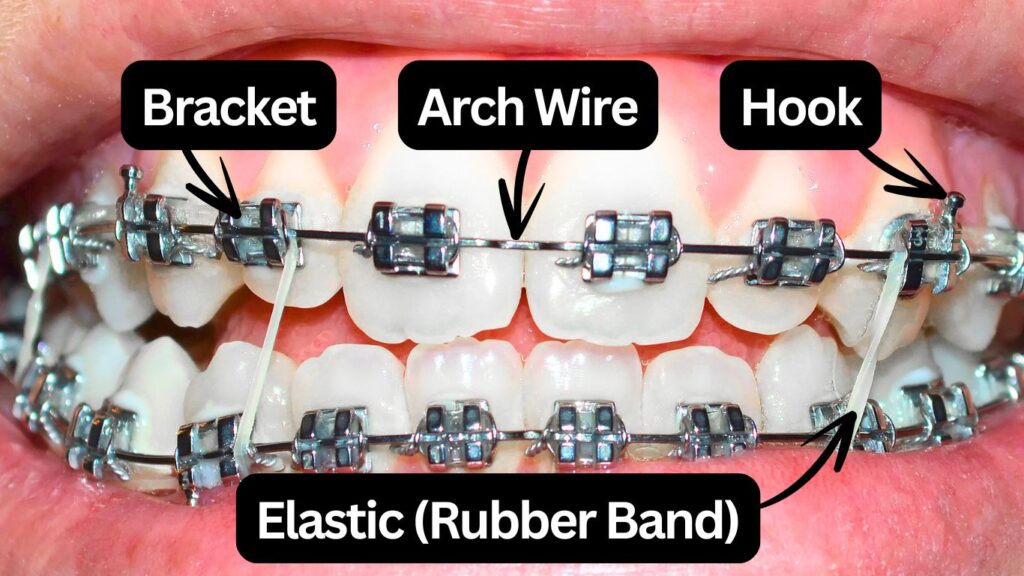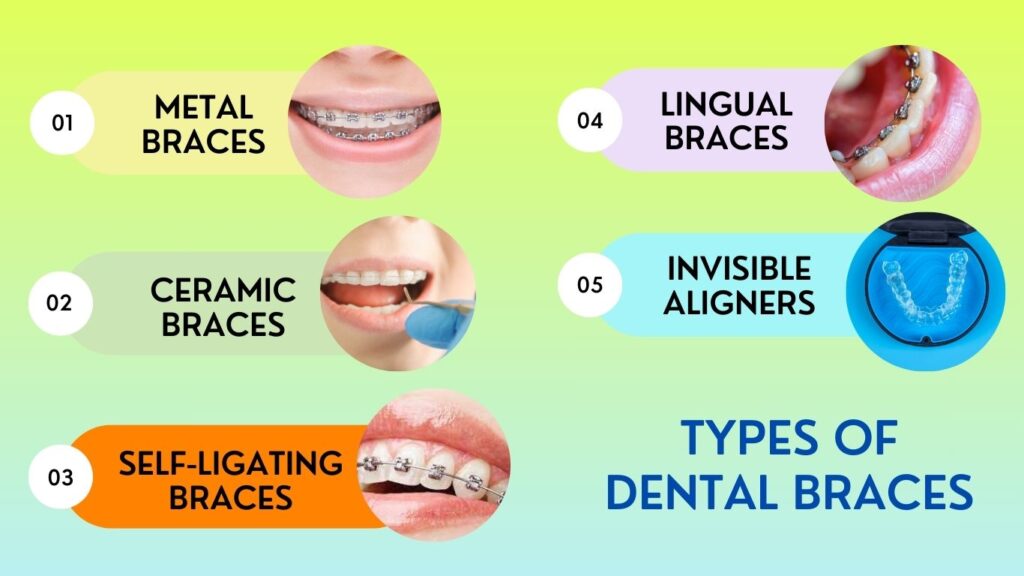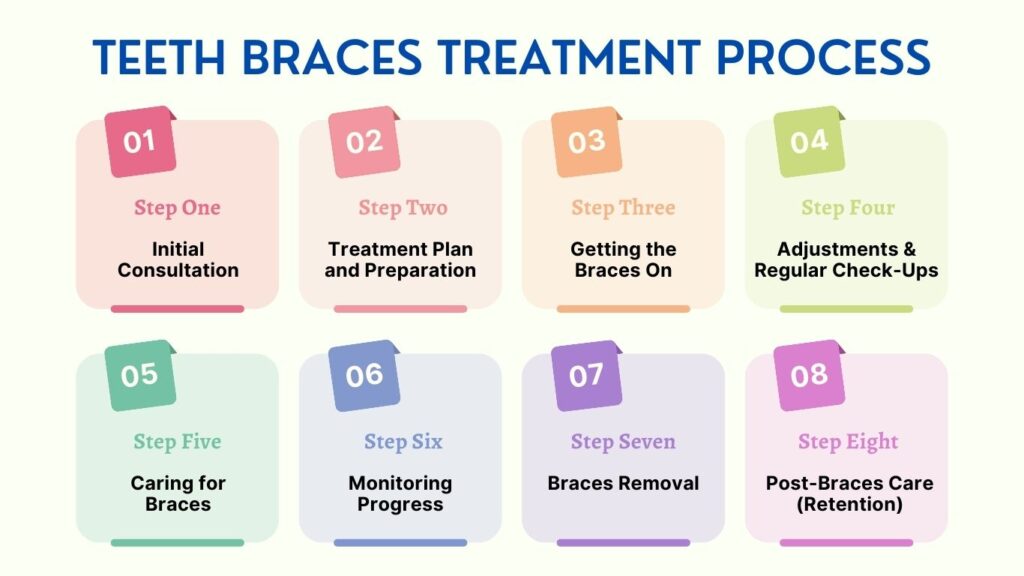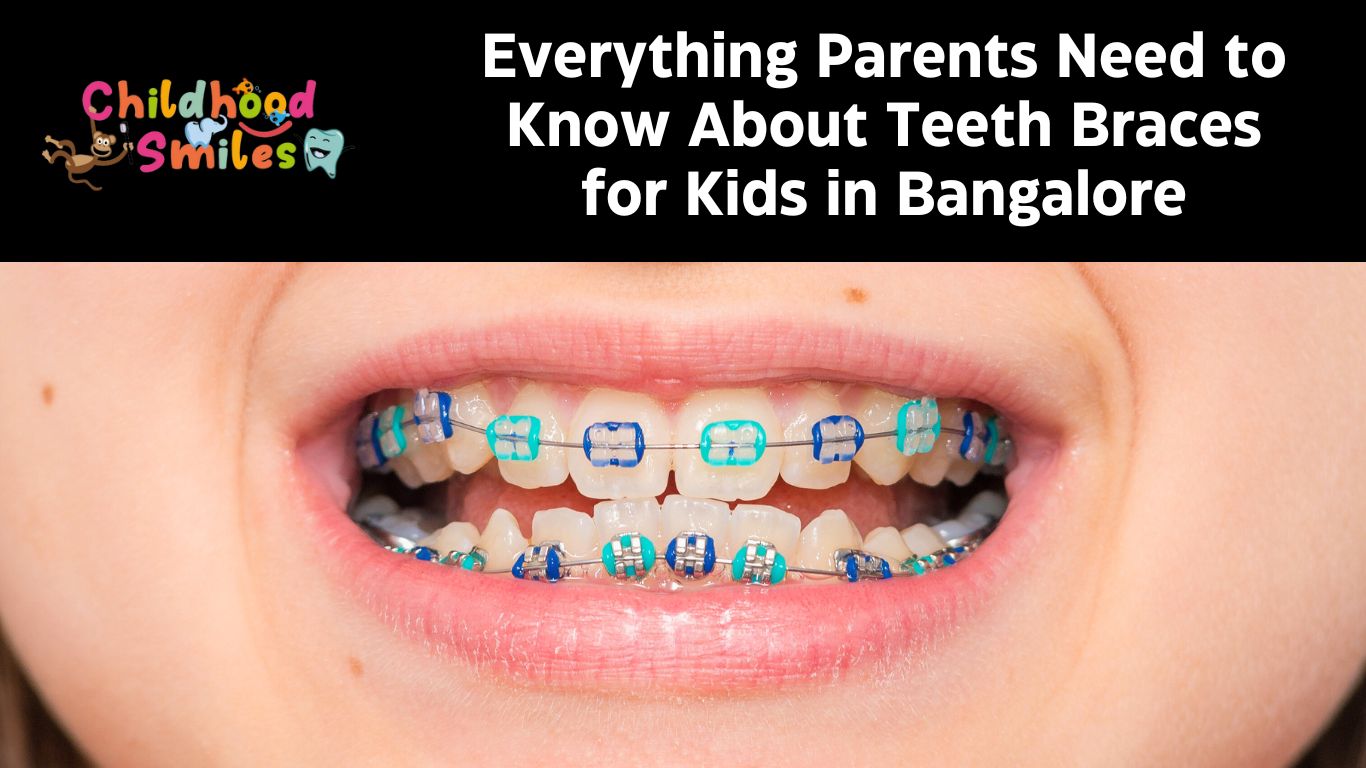Everything Parents Need to Know About Teeth Braces for Kids in Bangalore
Getting braces for your child can feel like a big decision, and it’s normal to have a lot of questions. What exactly are braces, and how do they work? Should you go for traditional metal braces or something less noticeable, like Invisalign / Clear Aligners? And when is the right time to start the process? In this blog, we’ll break down everything you need to know about teeth braces. We’ll cover the different types of braces, the steps involved in getting them, and how to care for them. Plus, we’ll talk about the benefits, potential risks, and what you can do to help your child maintain a healthy smile long after the braces come off.
What Are Dental Braces?
Dental braces are devices that help straighten teeth and fix bite issues. They’re made up of tiny brackets that are attached to your child’s teeth, connected by a thin wire. Over time, this setup gently moves your child’s teeth into the right position.

But braces aren’t just about having a straighter smile. They can help with a lot more, like fixing overcrowded teeth, closing gaps, and correcting problems with how your teeth meet when you bite down (like overbites or underbites). By fixing these issues, braces don’t just make smile look better, they make teeth healthier too!
Who Needs Braces?
Your child may need braces to correct orthodontic problems like:
- Crowded or Crooked Teeth: When there is not enough space in the jaw for all the teeth, causing them to overlap or become crooked (not aligned properly).
- Overbite/Underbite: When the upper or lower teeth extend too far, braces can help correct the bite. It can cause issues with the bite and aesthetics.
- Crossbite: When one or more of the upper teeth bite on the inside of the lower teeth i.e., don’t align properly when the mouth is closed.
- Open Bite: When there’s a gap between the upper and lower teeth even when the mouth is closed.
- Jaw Misalignment: Issues with the size or position of the upper and lower jaws relative to each other, which can affect bite and facial appearance.
- Gaps Between Teeth: Gaps or spaces between teeth can occur if there is too much space in the jaw.
- Speech Issues: Sometimes, misaligned teeth can cause speech problems, which braces can help improve.
- Difficulty Chewing or Biting: Braces can help correct bite issues that make eating difficult.
- Jaw Pain or TMJ Disorders: If jaw pain or temporomandibular joint (TMJ) disorders are caused by misalignment, braces may help alleviate the discomfort.
How Do Braces Work?
Teeth braces apply steady, gentle pressure to your teeth, gradually moving them where they need to go. The brackets and wires guide the teeth over time, and our orthodontist will adjust them every so often to make sure everything is progressing as it should. Depending on the situation, your child might need braces for a few months or a couple of years to get the best results.
Types of Braces
With the advancement of technology and materials braces come in many forms. They vary based on materials used to construct them, placement on the teeth, size and mechanism.

Metal Braces
It is the most common and traditional type of braces, consisting of metal brackets and wires. They are highly effective in treating a wide range of orthodontic issues and are generally more affordable than other options. However, they are also the most noticeable type of braces and can cause some discomfort due to the metal components.thodontic problems like.
Mini Braces
Mini braces are a smaller version of traditional metal braces, offering a more subtle appearance while still being effective. They are almost 30% smaller than traditional braces. They provide a less noticeable option and can be more comfortable due to their smaller size.
Ceramic Braces
Ceramic braces are similar to metal braces but use tooth-colored or clear brackets, making them less noticeable. They blend in with the natural color of the teeth, providing a more aesthetically pleasing option. Ceramic braces can be more prone to staining and may be more fragile compared to metal braces, which can lead to breakages or damage over time. They are also typically more expensive than metal braces.
Lingual Braces
Lingual braces are placed on the back (lingual) side of the teeth, making them completely invisible from the front. This is a great option for those who want a discreet treatment. However, lingual braces can be more challenging to clean and adjust, and they may cause more discomfort or speech difficulties initially. They are also generally more costly due to the customization required for the brackets.
Self-Ligating Braces
Self-ligating braces use brackets with a built-in mechanism to hold the archwire in place, eliminating the need for elastic or metal ties. This can lead to a reduction in friction, potentially shorter treatment times, and fewer visits to the orthodontist
Clear Aligners / Invisalign
Clear aligners (Invisalign) are a popular choice for those seeking a virtually invisible orthodontic treatment. They are removable, making it easier to maintain oral hygiene and eat without restrictions. The treatment requires a high level of discipline, as aligners must be worn for at least 22 hours of the day.
Teeth Braces Treatment Process
Getting teeth braces is a journey, and understanding the process can help you and your child feel more prepared and at ease. Here’s a step-by-step breakdown of what to expect when getting braces:

1. Initial Consultation
The first step in the braces journey is meeting with an orthodontist, a specialist in teeth alignment. During this initial consultation, the orthodontist will examine your child’s teeth, and take X-rays. This helps them determine the best treatment plan based on the specific alignment issues. The orthodontist will also discuss the different types of braces available and which option might be the best fit for your child’s needs.
2. Treatment Plan and Preparation
Once the treatment plan is decided, the orthodontist will explain the timeline and steps involved. If your child needs any additional dental work, like removing baby teeth or treating cavities, this will be done before the braces are given. The orthodontist will also make sure your child’s teeth are clean and healthy before moving forward.
3. Getting the Braces On
First, the orthodontist will clean and dry your child’s teeth. Then, they’ll apply a special adhesive to attach the brackets (the small metal or ceramic pieces) to each tooth. Once the brackets are in place, a thin wire is threaded through them and secured with tiny rubber bands. This appointment usually takes about 1-2 hours, and while it might feel a bit strange, it shouldn’t be painful.
4. Adjustments and Regular Check-Ups
After the braces are on, your child will need to visit our orthodontist regularly, usually every 4 to 8 weeks. During these appointments, the orthodontist will make adjustments to the wires and bands to keep the teeth moving in the right direction. These adjustments might cause some mild discomfort for a day or two, but it’s a sign that the braces are doing their job!
5. Caring for Braces
Throughout the treatment, taking care of the braces is crucial. This means brushing and flossing carefully around the brackets and wires, avoiding certain foods that could damage the braces (like sticky or hard foods), and following the orthodontist’s advice. Proper care helps prevent issues like tooth decay and ensures the treatment stays on track.
6. Monitoring Progress
The orthodontist will monitor the progress at each visit to make sure everything is moving according to plan. If any issues arise, like a broken bracket or wire, it’s important to get it fixed right away. The total treatment time depends on the complexity of the case, but most people wear braces for 1 to 3 years.
7. Braces Removal
When the treatment is complete and your child’s teeth are perfectly aligned, it’s time for the exciting part, getting the braces removed! This is a quick and painless process where the orthodontist will carefully take off the brackets and wires. Afterward, your child’s teeth will be thoroughly cleaned to remove any adhesive residue.
8. Post-Braces Care (Retention)
Once the braces are off, the next step is retention. Your child will likely be given a retainer to wear, which helps maintain the new position of their teeth. The retainer is typically worn full-time for a few months, then gradually reduced to nighttime wear. Following the orthodontist’s instructions for retainer use is key to keeping that new, straight smile in place for the long term.
How long do braces take to work?
One of the most common questions parents have about braces is: “How long will my child need to wear them?” The answer depends on several factors, but on average, most people wear braces for 1 to 3 years. However, every case is unique, and the exact duration can vary based on individual needs.
Factors That Affect Treatment Time:
- Severity of the Problem: If your child has minor alignment issues, like slightly crooked teeth, they may only need braces for a shorter period, possibly around 12 to 18 months. On the other hand, more complex problems, such as significant overcrowding, gaps, or bite issues, might require a longer treatment time, closer to the 2 to 3-year mark.
- Compliance: How well your child follows the orthodontist’s instructions can also affect the treatment timeline. Wearing elastics (rubber bands), using a retainer as instructed, and avoiding foods that could damage the braces are all important for keeping the treatment on track. The more compliant your child is, the faster they can get their braces off!
- Adjustments and Appointments: Regular visits to the orthodontist are key. During these check-ups, adjustments are made to the braces to ensure the teeth are moving correctly. Skipping or delaying appointments can extend the overall treatment time.
While wearing braces requires some patience, the results are worth it, a healthy, beautiful smile that can last a lifetime. And remember, even after the braces come off, wearing a retainer as directed is essential to maintaining the results and preventing the teeth from shifting back.
In short, the timeline for braces varies, but with the right care and attention, the process can be smooth and successful.
Is it really necessary to treat orthodontic problems?
Choosing whether or not to get dental braces for your child is a big decision, and it’s important to understand the potential risks of leaving alignment issues untreated. While braces can seem like a hassle, not addressing dental problems early on can lead to more serious complications down the road.
- Increased Risk of Tooth Decay and Gum Disease: When teeth are crowded, crooked, or misaligned, it can be much harder to clean them properly. Food particles and plaque can get trapped in tight spaces, making it difficult to reach with a toothbrush or floss. Over time, this can lead to cavities, gum inflammation, and even more serious issues like periodontal disease. Straightening the teeth with braces can make it easier to maintain good oral hygiene and prevent these problems.
- Jaw Pain and Discomfort: Misaligned teeth can cause your child’s bite to be off-balance, leading to strain on the jaw muscles and joints. This can result in chronic pain, discomfort, and even conditions like TMJ disorder (temporomandibular joint disorder), which affects the joint that connects the jaw to the skull. Over time, this pain can interfere with daily activities like eating and speaking. Braces help align the bite properly, reducing the risk of jaw problems in the future.
- Speech Difficulties: Teeth play a crucial role in speech, especially when it comes to pronouncing certain sounds. Misaligned teeth can cause speech problems, such as lisping or difficulty pronouncing certain words clearly. Addressing these alignment issues can help improve speech and boost your child’s confidence in communicating.
- Wear and Tear on Teeth: When teeth don’t fit together correctly, they can wear down unevenly over time. This can cause chips, cracks, and excessive wear on certain teeth, leading to further dental problems like tooth sensitivity or the need for crowns and fillings. Proper alignment through braces helps distribute the force of chewing evenly across all teeth, reducing the risk of damage.
- Lower Self-Esteem and Confidence: While braces are often seen as a way to improve dental health, they also have a significant impact on a child’s self-esteem. Misaligned or crooked teeth can make kids feel self-conscious about their smile, leading to lower confidence in social situations. By correcting these issues with braces, your child can gain a smile they’re proud to show off, boosting their confidence and overall well-being.
- Potential for More Expensive Treatments Later On: Orthodontic issues that are left untreated during childhood can become more complicated and costly to fix in adulthood. For example, untreated alignment problems might require extensive dental work, such as surgery or complex restorative procedures, later in life. Addressing these issues early with can prevent the need for more invasive and expensive treatments down the road.
What are the common side effects of braces?
It’s common for your child to experience some mild discomfort when they first get braces or after adjustments. This can include soreness in the teeth and gums, slight irritation on the inside of the cheeks, and a feeling of tightness. These side effects usually fade after a few days as your child gets used to the braces.
Do’s and Don’ts with Dental Braces.
Do’s:
- Brush and floss carefully around the brackets and wires.
- Attend all scheduled orthodontic appointments.
- Wear any additional appliances, like rubber bands or headgear, as instructed.
- Use orthodontic wax to prevent irritation.
Don’ts:
- Avoid sticky, chewy, or hard foods that can damage the braces (e.g., gum, popcorn, hard candies).
- Don’t chew on pens, pencils, or ice, as these can break the braces.
- Don’t skip your orthodontic appointments or neglect your oral hygiene.
Do braces hurt?
Braces don’t hurt when they’re put on, but your child may feel some discomfort or soreness afterward, especially after adjustments. This is normal and a sign that the braces are doing their job. The discomfort usually goes away within a few days and can be managed with wax or prescribed medicine.
What food should my child avoid with braces?
They should avoid foods that are sticky (like gum and caramel), hard (like nuts and raw carrots), or crunchy (like popcorn and chips), as these can damage the braces.
Can my child play sports with braces?
Yes, your child can still play sports while wearing braces! However, it’s important to wear a mouthguard to protect the braces and teeth from injury during contact sports. You can ask our orthodontist for a custom-made mouthguard that fits over the braces.
Are teeth extracted for orthodontic treatment?
In some cases, teeth may need to be extracted to create enough space for the remaining teeth to align properly. However, this isn’t always necessary. Our orthodontist will evaluate your child’s situation and decide if extractions are needed as part of the treatment plan.
How often will I need to take my child to the dental clinic for braces?
After the braces are placed, you’ll need to bring your child in for regular check-ups, usually every 4 to 8 weeks. During these visits, the orthodontist will make adjustments to the braces to keep the teeth moving in the right direction.
Will my child’s speech be affected by braces?
At first, your child may notice a slight change in their speech, especially if they have braces on their front teeth or are using appliances like expanders. However, this is usually temporary. As your child gets used to the braces, their speech should return to normal.

